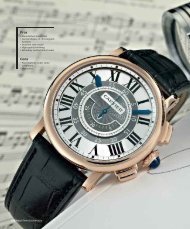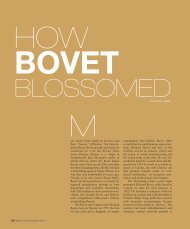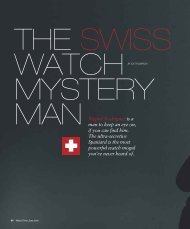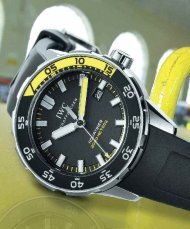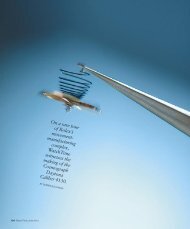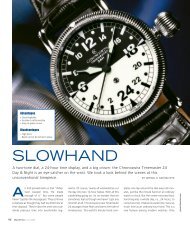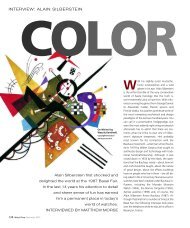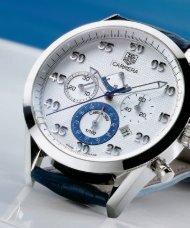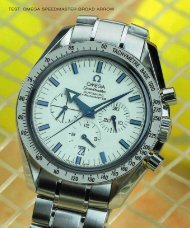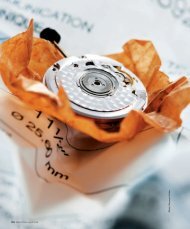WT_2006_01: DOUBLE TEST: SINN U1 VS. SINN U2
WT_2006_01: DOUBLE TEST: SINN U1 VS. SINN U2
WT_2006_01: DOUBLE TEST: SINN U1 VS. SINN U2
Create successful ePaper yourself
Turn your PDF publications into a flip-book with our unique Google optimized e-Paper software.
<strong>DOUBLE</strong> <strong>TEST</strong>: <strong>SINN</strong> <strong>U1</strong> <strong>VS</strong>. <strong>SINN</strong> <strong>U2</strong><br />
74 WatchTime February <strong>2006</strong>
Advantages<br />
+ The scratch-resistant bezel<br />
won’t snap off<br />
+ Scratch-resistant, non-reflective<br />
coating<br />
+ Attractive design<br />
+ Stay-dry technology<br />
Disadvantages<br />
– High surcharge compared to<br />
the price of the <strong>U1</strong><br />
Advantages<br />
+ The scratch-resistant bezel<br />
won't snap off<br />
+ Scratch-resistant, non-reflective<br />
coating<br />
+ Excellent rate results<br />
+ Favorable price<br />
Disadvantages<br />
– It takes time to get used to the<br />
unusual design<br />
photo: Marcus Krüger, Hamburg<br />
Submarine<br />
Steel<br />
“Warsaw” is the code word for “caution” on the high seas.<br />
A mariner expresses his experience and superiority with the<br />
phrase “Warsaw nautical miles.” Now Sinn has built two<br />
watches from submarine steel. They’re harder than all other<br />
steel watches. Are they the perfect divers’ watches?<br />
Along with its well-known pilots’ watches,<br />
Sinn can also boast several impressive<br />
timepieces for divers. The so-called “hydro<br />
technique” made it possible to build a<br />
quartz watch that can remain water-resistant<br />
to virtually any depth. Its case is completely<br />
filled with non-compressible oil. This technique<br />
is also used in the company’s EZM 2, which the<br />
professionals in the maritime unit of Germany’s<br />
anti-terrorism police force, the GSG 9, use to<br />
keep track of time during their missions.<br />
Sinn’s accumulated know-how prompted<br />
its technicians to begin developing even<br />
tougher divers’ watches. The results are the <strong>U1</strong><br />
and <strong>U2</strong>, and it’s no mere coincidence that the<br />
names of these watches sound as though they<br />
could also be the names of U-boats.<br />
In their search for materials from which to<br />
craft the cases of these new divers’ watches,<br />
Sinn chief Lothar Schmidt and his team found a<br />
special type of steel that, for several reasons,<br />
proved to be ideal for underwater wristwatches.<br />
Expressly developed by Germany’s metallurgical<br />
industry for U-boat construction, this alloy<br />
is used in new submarines of the 212 A<br />
class. This extraordinary alloy is highly resistant<br />
to corrosion by saltwater, extremely strong and<br />
BY JENS KOCH<br />
unusually elastic. These attributes are crucial<br />
because they help prevent a sub from springing<br />
a leak under the extreme pressure of deep<br />
dives or in the event of a collision. Furthermore,<br />
the alloy cannot be magnetized, thus<br />
protecting the vessel against magnetic sensors<br />
in robotic mines.<br />
The four 212 A U-boats that the German<br />
navy ordered have been built and are undergoing<br />
test operations at sea. Manufactured at the<br />
Howaldtswerke Deutsche Werft (HDW) in Kiel,<br />
they’re regarded as the world’s most advanced<br />
conventional U-boats. They’re also the first<br />
such vessels to be powered by fuel cells. This<br />
means they can dive and stay underwater for<br />
extremely long periods of time.<br />
Sinn’s engineers were particularly interested<br />
when they heard about this alloy’s ability to<br />
resist the corrosive effects of saltwater. Watch<br />
cases made of conventional steel alloys aren’t<br />
suitable for long-term underwater use. The<br />
ability to withstand corrosion from saltwater,<br />
which can cause crater-shaped scars in a metal’s<br />
surface, is measured in a unit called a<br />
“PRE,” which stands for “pitting resistance.”<br />
The maximum PRE value for stainless steel is<br />
26, but a metal doesn’t deserve to be de-<br />
February <strong>2006</strong> WatchTime 75
<strong>DOUBLE</strong> <strong>TEST</strong>: <strong>SINN</strong> <strong>U1</strong> <strong>VS</strong>. <strong>SINN</strong> <strong>U2</strong><br />
scribed as “seawater resistant” unless its PRE<br />
value is at least 32. U-boat steel has a PRE value<br />
of 38, which is high enough for professional<br />
divers. This steel won’t be damaged even if the<br />
watch isn’t rinsed with freshwater after immersion<br />
in the briny deep. But it’s not just corrosion<br />
resistance that makes this alloy so interesting<br />
for Sinn: this material can also be hardened<br />
very well using the Tegiment process.<br />
Sinn first experimented with hardened steel<br />
on its Model 756. The first ice-hardened variation<br />
achieved a value of 700 on the Vickers<br />
hardness scale. That’s an enormous improvement<br />
over the 316L steel alloy typically used in<br />
watches: 316L steel tops out at 220 on the<br />
Vickers scale. When Sinn’s specialists subjected<br />
316L steel to the Tegiment technique, they<br />
were able to increase its hardness to 1,200<br />
Vickers. Applying the same procedure to Uboat<br />
steel, they achieve a value of 1,500 Vickers.<br />
This means that the surfaces of the <strong>U1</strong> and<br />
76 WatchTime February <strong>2006</strong><br />
The green Viton insulator protects the ETA 2893-2 in the <strong>U2</strong> (left) and the ETA 2824-2 in the <strong>U1</strong>.<br />
<strong>U2</strong> divers’ watches are nearly seven times harder<br />
than the surfaces of ordinary steel wristwatches.<br />
This hardening procedure is performed<br />
only on the bezel because the Tegiment<br />
process is very laborious and takes several<br />
weeks to complete, but since the rotating<br />
bezel covers the entire case, it gives the case all<br />
necessary protection. Even before undergoing<br />
the Tegiment process, the U-boat steel of<br />
which the bezel, case and crown are made is<br />
already 40% to 50% harder than the 316L alloy.<br />
The case comes from SUG and is very nearly<br />
perfectly made. We searched for tool marks<br />
everywhere, even between the strap lugs, but<br />
were unable to find any. The glass pearl blasted<br />
surface is so fine it looks almost elegant.<br />
Lothar Schmidt didn’t want to compromise<br />
the scratch-resistance of the surfaces by using<br />
the soft non-reflective coating that’s ordinarily<br />
applied to watch crystals. Here, too, Schmidt<br />
sought a better solution. As so often occurs in<br />
the world of watchmaking, he found it in another<br />
discipline altogether: namely, in the technology<br />
used to improve the optical quality of<br />
lenses. This laborious and costly technological<br />
process creates a non-reflective layer with a<br />
value of 1,800 Vickers, nearly as hard as the<br />
2,000-Vickers value achieved by its sapphire<br />
substrate. After proving itself on Sinn’s Model<br />
900, this technique is now also used on the <strong>U1</strong><br />
and <strong>U2</strong>. Sinn pre-tenses its crystals before gluing<br />
them into place, thus enabling the construction<br />
to forego an unattractive white plastic<br />
insulating ring. A 1.4-mm-wide glue crevice<br />
ensures that the crystal never parts company<br />
with the case, even under de-pressurized conditions.<br />
Schmidt and his team also needed to be<br />
sure that the extremely hard rotating bezel<br />
would never get lost. Most manufacturers<br />
press the bezel onto the case from above. If<br />
you want to remove the bezel, all you do is ex-<br />
Argon’s comparatively large atoms ensure that the smaller water molecules<br />
cannot find any space for themselves inside the case.
<strong>DOUBLE</strong> <strong>TEST</strong>: <strong>SINN</strong> <strong>U1</strong> <strong>VS</strong>. <strong>SINN</strong> <strong>U2</strong><br />
DATA<br />
<strong>SINN</strong> <strong>U2</strong><br />
Manufacturer: Sinn Spezialuhren<br />
GmbH & Co. KG, Im Füldchen 5-7, 60489<br />
Frankfurt, Germany<br />
Model: <strong>U2</strong><br />
Reference number: 1020.020<br />
Functions: Hours, minutes, seconds, date;<br />
uni-directionally rotating bezel; stop-seconds<br />
function.<br />
Movement: Self-winding ETA 2893-2;<br />
diameter = 25.6 mm; height = 4.1 mm;<br />
28,800 vibrations per hour; 21 jewels;<br />
Incabloc shock absorption; power reserve of<br />
about 42 hours.<br />
Case: U-boat steel, glass pearl blasted; divers’ rotating<br />
bezel is made of steel hardened to 1500<br />
HV and is impossible to lose; threaded screw-in<br />
back; domed sapphire crystal is non-reflective on<br />
both its surfaces, 4.6 mm thick, and given extrahard<br />
1800 HV non-reflective treatment on its<br />
outer surface; argon filling; two copper sulfate<br />
desiccant capsules; special oil for a temperature<br />
range from -45° to +80° Celsius; water-resistant<br />
to 2,000 meters.<br />
Band and clasp: Rubber strap; secure folding<br />
clasp made of steel with divers’ extension<br />
piece.<br />
Rate results:<br />
(Deviations in seconds per 24 hours)<br />
Dial up: +3<br />
Dial down: +7<br />
Crown up: -4<br />
Crown down: +1<br />
Crown left: –3<br />
Crown right: –1<br />
Greatest deviation of rate: 11<br />
Average deviation: +0.5<br />
Mean amplitude<br />
Flat positions: 317°<br />
Hanging positions: 274°<br />
Dimensions: Diameter = 44 mm;<br />
height = 15.45 mm; weight: 170 grams.<br />
Price: $2,200<br />
ert a little leverage and snap it free. But under<br />
unfavorable conditions, a pressure-fit bezel of<br />
this kind can be inadvertently snapped off the<br />
case, for example, if a diver snags it on an underwater<br />
rock.<br />
To prevent this from happening, Sinn developed<br />
an impossible-to-lose rotating bezel. An<br />
open tension ring, which fits into a groove on<br />
the bezel, is pressed by three little screws into a<br />
corresponding groove on the case. This creates<br />
a secure bond that can be readily (but never accidentally)<br />
undone whenever desired. The bezel<br />
runs smoothly on three elastically borne<br />
78 WatchTime February <strong>2006</strong><br />
The secure folding clasp with divers’ extension piece isn’t made from U-boat steel, but it’s<br />
very durable anyway.<br />
balls that also let the bezel click incrementally<br />
into place. Here, too, Sinn has found a solution<br />
that combines elegance and longevity.<br />
The luminous index on the bezel consists of<br />
an inlaid piece of artificial material that contains<br />
Super-LumiNova. The large amount of luminous<br />
substance here, as well as its copious<br />
use on the hands and on the dial’s indices, assures<br />
that these U-boat watches keep glowing<br />
in the dark much longer than ordinary wristwatches.<br />
Even shortly before sunrise, the time<br />
can still be clearly read from the dials of Sinn’s<br />
U-boat watches.<br />
Lothar Schmidt isn’t just an engineer. He’s<br />
also a perfectionist. His critical eye misses nothing,<br />
not even seemingly minor details such as<br />
insulators. Viton is the material of choice for<br />
the insulators on Sinn’s U-boat watches. This<br />
green material has a longer lifespan than conventional<br />
black nitril insulators. Furthermore,<br />
Viton allows only one-fourth as much gas and<br />
atmospheric moisture to penetrate into the<br />
watch’s interior. Last but not least, Viton is<br />
more resistant to corrosion by many chemicals.<br />
With so many attributes in its favor, one wonders<br />
why all watch manufacturers haven’t<br />
switched to Viton insulators. One reason is the<br />
higher price of such insulators. Nitril rings can<br />
be had for less than one euro; their Viton counterparts<br />
cost more than one euro each. If insulating<br />
rings aren’t available in the desired size,<br />
several hundred euros must be spent to make<br />
the tools needed to manufacture them. Lothar<br />
Schmidt doesn’t shy away from the additional<br />
DATA<br />
<strong>SINN</strong> <strong>U1</strong><br />
Manufacturer: Sinn Spezialuhren<br />
GmbH & Co. KG, Im Füldchen 5-7, 60489<br />
Frankfurt, Germany<br />
Model: <strong>U1</strong><br />
Reference number: 1<strong>01</strong>0.<strong>01</strong>0<br />
Functions: Hours, minutes, seconds, date; unidirectionally<br />
rotating bezel; stop-seconds function.<br />
Movement: Self-winding ETA 2824-2;<br />
diameter = 25.6 mm; height = 4.8 mm;<br />
28,800 vibrations per hour; 25 jewels;<br />
Incabloc shock absorption; power reserve of<br />
about 40 hours.<br />
Case: U-boat steel, glass pearl blasted; divers’ rotating<br />
bezel is made of steel hardened to 1500<br />
HV and is impossible to lose; threaded screw-in<br />
back; sapphire crystal is non-reflective on both its<br />
surfaces, 3.5 mm thick, and given extra-hard<br />
1800 HV non-reflective treatment on its outer<br />
surface; argon filling; water-resistant to 1,000<br />
meters.<br />
Band and clasp: Rubber strap; secure folding<br />
clasp made of steel with divers’ extension<br />
piece.<br />
Rate results:<br />
(Deviations in seconds per 24 hours)<br />
Dial up: +5<br />
Dial down: +4<br />
Crown up: +3<br />
Crown down: +4<br />
Crown left: +4<br />
Crown right: +4<br />
Greatest deviation of rate: 2<br />
Average deviation: +4<br />
Mean amplitude<br />
Flat positions: 305°<br />
Hanging positions: 294°<br />
Dimensions: Diameter = 44 mm;<br />
height = 14.35 mm; weight: 170 grams.<br />
Price: $1,200
expenses: he uses Viton on the back of the case, as well as for the crown’s<br />
two O-ring insulators and its flat insulator.<br />
The meaning of the first part of the names “<strong>U1</strong>” and “<strong>U2</strong>” isn’t hard to<br />
guess: “U” stands for “U-boat steel.” But what do the numbers “1” and<br />
“2” mean? They allude to the water-resistance. The <strong>U1</strong> is water-resistant<br />
to 1,000 meters. The <strong>U2</strong> remains impenetrable down to twice that depth.<br />
The <strong>U2</strong> achieves this deep-diving water-resistance in part thanks to its 4.6mm-thick<br />
sapphire crystal. This crystal is domed and significantly thicker<br />
than the one on the <strong>U1</strong>, which is flat.<br />
But there are other differences between the <strong>U1</strong> and <strong>U2</strong>. From the start,<br />
the <strong>U2</strong> was conceived to be a timepiece for professional missions, so it<br />
bears the additional designation “EZM 5.” Its design is derived from the<br />
EZM watches, but has undergone further evolution. The guiding principle<br />
behind this philosophy is to use unobtrusive colors to display information<br />
of lesser importance.<br />
As an instrument for use on professional missions, the <strong>U2</strong> is also<br />
equipped with an improved version of Sinn’s “stay-dry” technology. Its<br />
case is filled with argon, one of the noble gases. Argon’s comparatively<br />
large atoms ensure that the smaller water molecules cannot find any<br />
space for themselves inside the case. If small amounts of water vapor<br />
nonetheless manage to penetrate, they’re soon absorbed by the copper<br />
sulfate inside three desiccant capsules. This means that infiltrating water<br />
molecules can’t do any damage and it also assures that the crystal won’t<br />
fog up when the watch undergoes a temperature change. The copper<br />
sulfate is originally white, but it gradually changes to blue as it absorbs<br />
moisture and approaches saturation. The window that lets you keep tabs<br />
on the change to blue is no longer in the case (as it was on Sinn’s earlier<br />
version), but is now integrated into the dial at the “6.” Without the aperture,<br />
the case is even less permeable because any opening in a watch’s<br />
case is a potential Achilles’s heel.<br />
Another technical innovation lets Sinn guarantee this watch’s flawless<br />
performance even when it’s exposed to extreme temperatures. Thanks to<br />
the 66-228 oil that was developed expressly for Sinn, this watch continues<br />
Plenty of Super-LumiNova keeps these U-boat watches glowing for<br />
a long time.
<strong>DOUBLE</strong> <strong>TEST</strong>: <strong>SINN</strong> <strong>U1</strong> <strong>VS</strong>. <strong>SINN</strong> <strong>U2</strong><br />
to run blithely at temperatures ranging from<br />
–45° to +80° Celsius. Every <strong>U2</strong> is tested for 24<br />
hours at the lowest guaranteed temperature<br />
inside a frigid chamber. This oil is used at all lubricated<br />
locations, including the pallet jewels.<br />
Although the company doesn’t explicitly say<br />
so, Sinn uses this same special oil on most of its<br />
other watches, including the <strong>U1</strong>.<br />
The author wore the <strong>U2</strong> during a 10-day<br />
vacation. Man and machine swam in seawater<br />
at a balmy 26° C., a temperature at which saltwater<br />
really gets its teeth into ordinary steel<br />
surfaces. We also dug through fine sand on<br />
the beach and hiked in the mountains on hot<br />
afternoons. The author survived well enough,<br />
and his <strong>U2</strong> came through with flying colors.<br />
The rubber strap still looks brand new, too.<br />
And even the business end of a screwdriver<br />
couldn’t scratch the hardened steel bezel or<br />
the non-reflective coating on the crystal.<br />
The rubber strap fits solidly between the<br />
lugs and contributes to the watch’s up-to-date<br />
good looks. Sinn has taken a great leap forwards<br />
here. Furthermore, the strap curves<br />
downwards at an angle that makes it comfortable<br />
for even a smaller wrist, despite the<br />
watch’s 44-mm-diameter case. The dark gray<br />
color of the steel radiates an aura of reliability.<br />
We prefer the design of the <strong>U2</strong>; the <strong>U1</strong> looks a<br />
bit too boxy for our taste. On the other hand,<br />
the <strong>U1</strong> is king of the hill as far as its cost-benefit<br />
ratio is concerned: $1,200 is an inarguably<br />
low price to pay for a watch with this much<br />
high-tech refinement packed into it. Furthermore,<br />
the <strong>U1</strong> contains the best-quality version<br />
of ETA’s Caliber 2824-2. A rate deviation of just<br />
two seconds among the several positions is<br />
well within chronometer norms. On the wrist, it<br />
gained a negligible two seconds per day. The<br />
ETA 2893-2 inside the <strong>U2</strong> didn’t perform quite<br />
as well: it lost three seconds per 24 hours on<br />
the wrist and posted a large difference of 11<br />
seconds among the several positions. The surcharge<br />
for the <strong>U2</strong> buys you water-resistance to<br />
a greater depth, “stay-dry” technology inside<br />
the case, and the display of the time in a second<br />
time zone. Though it costs more than the <strong>U1</strong>,<br />
the $2,200 charged for the <strong>U2</strong> is by no means<br />
exorbitant for such an admirable union of functionality<br />
and beauty. ■<br />
80 WatchTime February <strong>2006</strong><br />
<strong>TEST</strong> RESULTS<br />
Sinn <strong>U2</strong><br />
Band and clasp (max. 10 points): Like those<br />
on the <strong>U1</strong>; soft rubber strap; sturdy clasp with<br />
divers’ extension piece; visually and functionally<br />
well-designed. 8<br />
Operation (5): The same good crown as on the<br />
<strong>U1</strong>; along with the stop-seconds function and<br />
the rapid adjustment for the date display, this<br />
model also allows rapid adjustment for the display<br />
of the time in a second time zone. 5<br />
Case (10): Even more water-resistant than the<br />
<strong>U1</strong>, with stay-dry technology inside the case,<br />
which is very well-crafted and protected by an<br />
extremely scratch-resistant, impossible-to-lose,<br />
rotating bezel. 9<br />
Design (15): The <strong>U2</strong> is clearly designed to measure<br />
time on underwater missions; it has an unobtrusive<br />
24-hour display for the time in a second<br />
zone and it boasts beautifully shaped, highly<br />
functional hands and indices. The domed crystal<br />
looks good on the <strong>U2</strong>; the crystal above the <strong>U1</strong>’s<br />
dial is flat. 13<br />
Legibility (5): Here, too, this is as good as it<br />
gets. The second time zone display is also unmistakably<br />
legible under daylight conditions. 5<br />
Wearing comfort (10): The case is slightly slimmer<br />
than that of the <strong>U1</strong>; the wearing comfort is<br />
equally good. 9<br />
Movement (20): The insignia on the rotor and<br />
the wide temperature range for the oil are the<br />
only changes made to ETA’s standard caliber. 12<br />
Rate results (10): Eleven seconds of deviation<br />
between the several positions could stand some<br />
improvement. 7<br />
Overall rating (15): Still a good price, but significantly<br />
more costly than the <strong>U1</strong> because of<br />
the stay-dry technology and the greater depth<br />
of water-resistance. 13<br />
TOTAL: 81 points<br />
<strong>TEST</strong> RESULTS<br />
Sinn <strong>U1</strong><br />
Band and clasp (max. 10 points): The velvety<br />
rubber strap and the sturdy folding clasp with<br />
divers’ extension piece look good; they combine<br />
high quality with a high degree of functionality.<br />
8<br />
Operation (5): When it’s unscrewed, the crown<br />
disengages from the winding staff, turns easily<br />
and can be readily pulled into the various positions;<br />
the watch has a stop-seconds function and<br />
the date display can be rapidly reset. 5<br />
Case (10): The very well-crafted and extremely<br />
water-resistant case evokes added enthusiasm<br />
thanks to its extremely scratch-resistant, impossible-to-lose,<br />
rotating bezel. 9<br />
Design (15): The indices recall the silhouette of a<br />
submarine moving toward the viewer; the design<br />
is appropriate for a U-boat watch, but the styling<br />
is a little too boxy. 12<br />
Legibility (5): By day or by night, the legibility<br />
couldn’t be better. 5<br />
Wearing comfort (10): Despite its heaviness,<br />
the watch is very comfortable on the wrist; the<br />
crown can’t hurt the top of the wrist. 9<br />
Movement (20): The unaltered ETA movement<br />
is sturdy and reliable and has proven itself in<br />
countless wristwatches. 11<br />
Rate results (10): Superlative performance! A<br />
mere two seconds’ deviation among the several<br />
positions, and scarcely any decline in amplitude.<br />
10<br />
Overall rating (15): An uncommonly good<br />
price for a timepiece with so much fine technology.<br />
15<br />
TOTAL: 84 points



